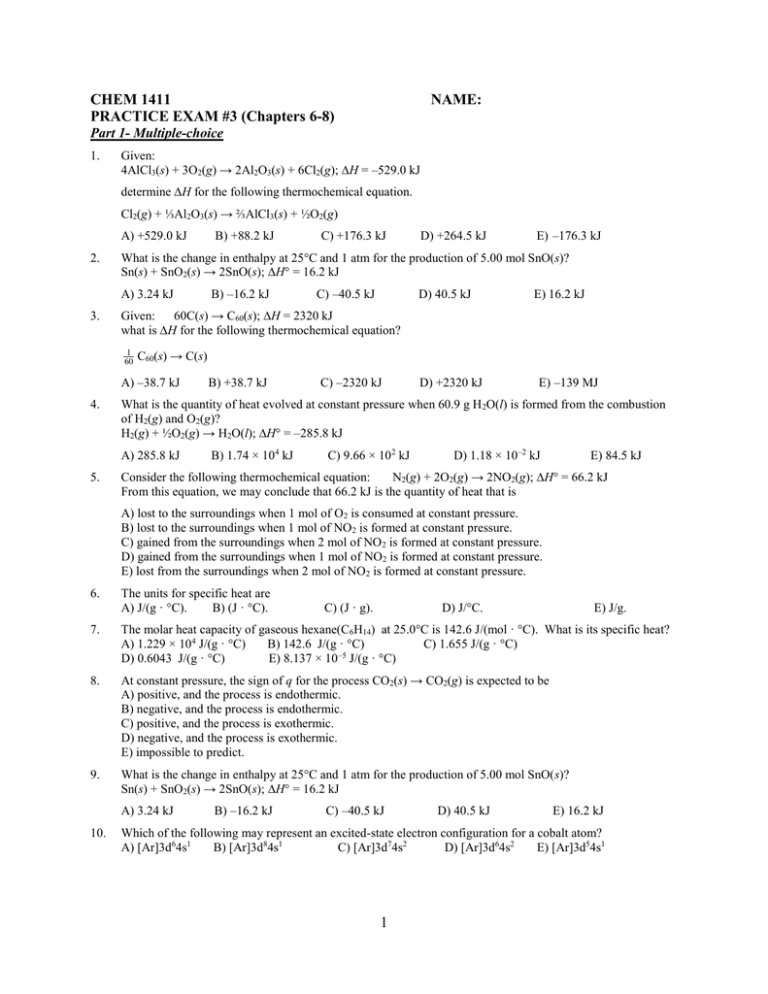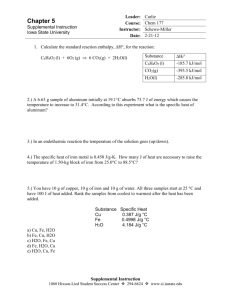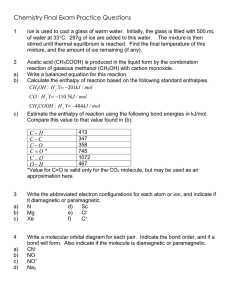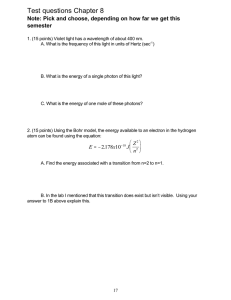1411-Practice Exam 3 (ch6-8).doc
advertisement

CHEM 1411 PRACTICE EXAM #3 (Chapters 6-8) NAME: Part 1- Multiple-choice 1. Given: 4AlCl3(s) + 3O2(g) → 2Al2O3(s) + 6Cl2(g); ∆H = –529.0 kJ determine ∆H for the following thermochemical equation. Cl2(g) + ⅓Al2O3(s) → ⅔AlCl3(s) + ½O2(g) A) +529.0 kJ 2. E) –176.3 kJ B) –16.2 kJ C) –40.5 kJ D) 40.5 kJ E) 16.2 kJ C60(s) → C(s) A) –38.7 kJ B) +38.7 kJ C) –2320 kJ D) +2320 kJ E) –139 MJ What is the quantity of heat evolved at constant pressure when 60.9 g H 2O(l) is formed from the combustion of H2(g) and O2(g)? H2(g) + ½O2(g) → H2O(l); ∆H° = –285.8 kJ A) 285.8 kJ 5. D) +264.5 kJ Given: 60C(s) → C60(s); ∆H = 2320 kJ what is ∆H for the following thermochemical equation? 1 60 4. C) +176.3 kJ What is the change in enthalpy at 25°C and 1 atm for the production of 5.00 mol SnO(s)? Sn(s) + SnO2(s) → 2SnO(s); ∆H° = 16.2 kJ A) 3.24 kJ 3. B) +88.2 kJ B) 1.74 × 104 kJ C) 9.66 × 102 kJ D) 1.18 × 10–2 kJ E) 84.5 kJ Consider the following thermochemical equation: N2(g) + 2O2(g) → 2NO2(g); ∆H° = 66.2 kJ From this equation, we may conclude that 66.2 kJ is the quantity of heat that is A) lost to the surroundings when 1 mol of O2 is consumed at constant pressure. B) lost to the surroundings when 1 mol of NO2 is formed at constant pressure. C) gained from the surroundings when 2 mol of NO 2 is formed at constant pressure. D) gained from the surroundings when 1 mol of NO2 is formed at constant pressure. E) lost from the surroundings when 2 mol of NO2 is formed at constant pressure. 6. The units for specific heat are A) J/(g · °C). B) (J · °C). C) (J · g). D) J/°C. E) J/g. 7. The molar heat capacity of gaseous hexane(C6H14) at 25.0°C is 142.6 J/(mol · °C). What is its specific heat? A) 1.229 × 104 J/(g · °C) B) 142.6 J/(g · °C) C) 1.655 J/(g · °C) D) 0.6043 J/(g · °C) E) 8.137 × 10 –5 J/(g · °C) 8. At constant pressure, the sign of q for the process CO2(s) → CO2(g) is expected to be A) positive, and the process is endothermic. B) negative, and the process is endothermic. C) positive, and the process is exothermic. D) negative, and the process is exothermic. E) impossible to predict. 9. What is the change in enthalpy at 25°C and 1 atm for the production of 5.00 mol SnO(s)? Sn(s) + SnO2(s) → 2SnO(s); ∆H° = 16.2 kJ A) 3.24 kJ 10. B) –16.2 kJ C) –40.5 kJ D) 40.5 kJ E) 16.2 kJ Which of the following may represent an excited-state electron configuration for a cobalt atom? A) [Ar]3d64s1 B) [Ar]3d84s1 C) [Ar]3d74s2 D) [Ar]3d64s2 E) [Ar]3d54s1 1 11. The elements that are filling the 5f subshell are called A) lanthanides. B) main-group elements. D) alkali metals. E) actinides C) transition elements. 12. Which of the following atoms is paramagnetic in its ground state? A) Fe B) Ne C) Be D) Cd E) Sr 13. In which of the series of elements listed below would the elements have most nearly the same atomic radius? A) Sc, Ti, V, Cr B) Na, K, Rb, Cs C) B, Si, As, Te D) F, Cl, Br, I E) Na, Mg, Al, Si 14. Sodium and potassium have similar chemical and physical properties. This is best explained by the fact that both elements A) are active metals. B) are in Period 1 of the periodic table. C) have the same ground-state valence-electron configuration. D) have low relative atomic masses. E) have relatively low first ionization energies. 15. How many values are there for the magnetic quantum number when the value of the angular momentum quantum number is 4? A) 1 B) 4 C) 10 D) 16 E) 9 16. Which of the following subshells does not exist? A) 2s B) 3p C) 4d D) 3f E) 6g 17. Which of the following sets of quantum numbers (n, l, ml, ms) is not permissible? A) 1 0 0 +½ B) 4 0 0 -½ C) 2 2 1 +½ D) 3 1 0 -½ E) 3 2 -2 -½ 18. How many orbitals have the set of quantum numbers n = 4 and l = 1? A) 1 B) 5 C) 3 D) 7 19. E) 9 What is the value of the spin quantum number for an electron in a 5f orbital? A) 5 B) 3 C) +½ D) –½ E) either +½ or –½ 20. What is the value of the principal quantum number for an electron in a 3p orbital? A) 3 B) 1 C) –3 D) +½ E) –½ 21. The radii of the species Cl, Cl+, and Cl– decrease in the following order: A) Cl+ > Cl > Cl–. B) Cl+ > Cl– > Cl. C) Cl > Cl – > Cl+. D) Cl > Cl+ > Cl–. E) Cl– > Cl > Cl+. 22. A bond in which an electron pair is unequally shared by two atoms is A) ionic. B) polar covalent. C) nonpolar covalent. D) coordinate covalent. E)metallic. 23. An atom of which of the following elements has the highest electronegativity? A) K B) Ba C) Si D) Br E) As 24. All of the following species have ground-state noble-gas electron configurations except A) K+. B) P3–. C) Ge4+. D) I–. E) Kr 25. The Cr2+ ion would be expected to have ____ unpaired electrons. A) 0 B) 1 C) 2 D) 3 2 E) 4 26. 27. Which of the following species is isoelectronic with Xe? A) Kr B) Rb+ C) Tl3+ D) Se2– The following species, A) protons. 28. 31 15 P 3 , B) electrons. 37 17 Cl , and 40 20 C) neutrons. E) Ba2+ Ca 2+ , all have the same number of D) isotopes. Which of the following atoms is the most electronegative? A) B B) Na C) N D) Cs E) nucleons. E) Al 29. In which pair do both compounds exhibit predominantly ionic bonding? A) PCl5 and HF B) Na2SO3 and BH3 C) KI and O3 D) NaF and H2O E) RbCl and CaO 30. Atoms of an element X have the ground-state electron configuration 1s22s22p63s23p4. What type of ion is X most likely to form? A) X6+ B) X4+ C) X– D) X2– E) X3– Part II – Show your all your work. 31. A 63.2-g sample of cobalt (s = 0.421 J/(g · °C)), initially at 187.3°C, is placed in an insulated vessel containing 222.4 g of water (s = 4.18 J/(g · °C)), initially at 11.8°C. Once equilibrium is reached, what is the final temperature of the metal–water mixture? Neglect the heat capacity of the vessel. 32. Using the following data, calculate the standard enthalpy of reaction for the coal gasification process 2C(s) + 2H2O(g) → CH4(g) + CO2(g). Given the following equations: C(s) + H2O(g) → CO(g) + H2(g); ∆H° = +131.3 kJ CO(g) + H2O(g) → CO2(g) + H2(g); ∆H° = –41.2 kJ CO(g) + 3H2(g) → CH4(g) + H2O(g); ∆H° = –206.1 kJ 3 33. What is the standard enthalpy of formation of liquid n-butanol, CH3CH2CH2CH2OH? CH3CH2CH2CH2OH(l) + 6O2(g) → 4CO2(g) + 5H2O(l); ∆H° = –2675 kJ Substance CO2(g) H2O(l) ∆H°f (kJ/mol) –393.5 –285.8 34. Consider the following atoms and ions; Cr, Cr3+, Bra) write electron configuration for Brb) write core configuration Cr3+ c) draw energy diagram representation for Cr d)determine the total number of unpaired electrons in Cr e) identify Cr3+ as paramagnetic or diamagnetic f) which block does Br belong to? g) which block does Cr belong to? h) identify the type of bond that will form between Cr and Br. 35. For the electronic transition from n = 3 to n = 5 in the hydrogen atom, calculate the energy, and wavelength (in nm). 4









